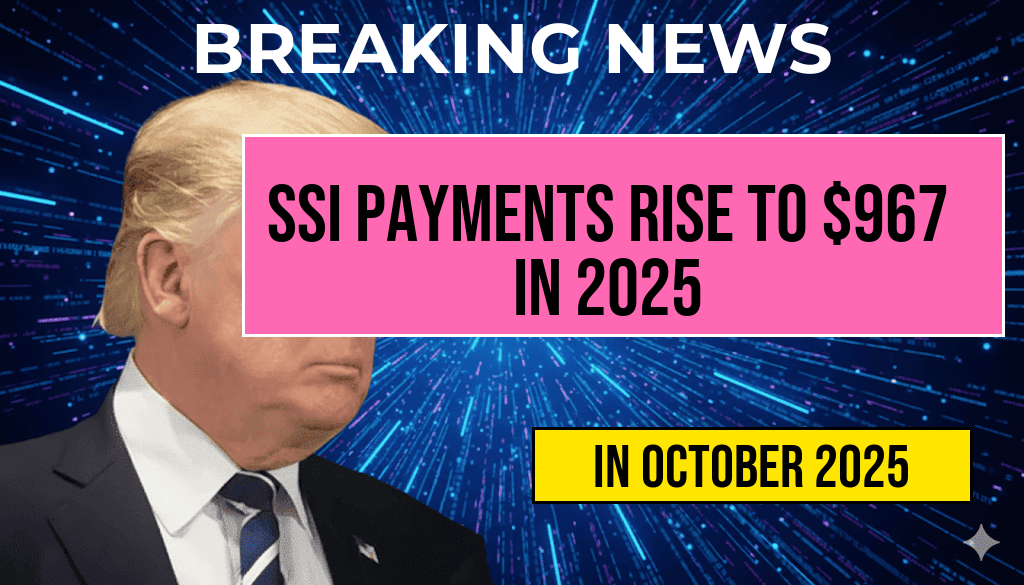The Social Security Administration (SSA) has announced a significant increase in Supplemental Security Income (SSI) benefits, set to take effect starting January 2025. The federal monthly payment for individuals receiving SSI will rise to $967, marking one of the largest annual adjustments in recent years. This adjustment reflects the ongoing efforts to keep pace with inflation and rising living costs, providing much-needed relief for millions of Americans who depend on these benefits for basic needs. The increase, which aligns with the annual cost-of-living adjustment (COLA), aims to help beneficiaries counteract inflationary pressures that have impacted prices for housing, food, healthcare, and other essentials. The new rate will impact approximately 8 million SSI recipients across the country, including many seniors and individuals with disabilities, and is expected to influence state-level programs and supplemental benefits as well.
Understanding the SSI Benefit Increase
The Basis for the Adjustment
The federal increase in SSI payments is determined annually based on the Consumer Price Index for Urban Wage Earners and Clerical Workers (CPI-W). The COLA for 2025 was announced earlier this year by the SSA, reflecting a 7.2% rise in inflation-adjusted costs since the previous year. This percentage is applied to the current maximum federal benefit, resulting in the new monthly payment of $967. Historically, such significant increases are relatively rare, and they are designed to ensure that the purchasing power of recipients does not diminish over time due to inflation.
Impact on Beneficiaries
For individuals relying solely on SSI benefits, this increase may make a tangible difference in managing daily expenses. As the average rent across many urban areas continues to rise, the higher payment can help mitigate some of these costs. Additionally, recipients may see adjustments in related programs and state benefits, which often base their calculations on federal rates. The adjustment is also projected to influence the Supplemental Nutrition Assistance Program (SNAP), Medicaid, and other social safety net initiatives that are tied to federal benefit levels.
Broader Context and Related Changes
Inflation and Social Security
The COLA adjustment for 2025 is part of a broader trend of increasing social safety net benefits in response to inflationary pressures. Historically, when inflation surges, federal benefit programs are adjusted to prevent erosion of real income. The recent increase marks a shift toward more responsive adjustments, recognizing the economic challenges faced by vulnerable populations. The SSA notes that the 7.2% COLA is among the highest in recent decades, driven by persistent inflation that affected consumer prices nationwide.
Comparison with Previous Years
| Year | Percentage Increase | Federal Benefit (per month) |
|---|---|---|
| 2020 | 1.6% | $783 |
| 2021 | 1.3% | $794 |
| 2022 | 5.9% | $841 |
| 2023 | 8.7% | $914 |
| 2024 | 3.2% | $943 |
| 2025 | 7.2% | $967 |
State-Level Effects and Additional Benefits
State Supplementation and Program Adjustments
Many states provide supplemental payments or have programs that increase the total benefits for SSI recipients. These supplements vary significantly depending on the state, with some offering additional monthly payments to better match local living costs. The federal increase to $967 often prompts states to reevaluate their supplementary benefits, which can further improve the financial stability of beneficiaries.
Implications for the Broader Social Safety Net
The rise in SSI benefits is expected to ripple through other social programs, including Medicaid and housing assistance programs. In some states, increased federal benefits may lead to adjustments in eligibility thresholds or benefit calculations, offering broader financial relief. Advocacy groups have emphasized that such adjustments are crucial given ongoing economic uncertainties and rising costs for essentials like healthcare and rent.
Looking Ahead
As the new benefit rate takes effect, recipients and advocates will closely monitor its impact on household stability and economic well-being. The SSA has reiterated its commitment to adjusting benefits annually to reflect inflation and ensure that vulnerable populations maintain access to necessary resources. For more information on the SSI program and upcoming changes, visit the SSA’s official website (ssa.gov/benefits/ssi) and consult resources provided by reputable organizations such as the Social Security Administration or the Congressional Research Service.
Frequently Asked Questions
What is the new federal monthly payment amount for SSI recipients starting January 2025?
The federal monthly payment for SSI recipients will increase to $967 starting January 2025.
Why is the SSI payment amount increasing in 2025?
The increase is due to a cost-of-living adjustment (COLA) approved to help account for inflation and ensure that SSI benefits maintain their purchasing power.
Who is eligible for the increased SSI payments?
Individuals eligible for Supplemental Security Income (SSI) benefits who meet the income and resource limits are eligible to receive the increased monthly payments.
Will the increase in SSI payments affect other federal benefits?
The COLA increase primarily impacts SSI payments but may indirectly influence other federal benefits that are linked to inflation adjustments.
When will recipients see the new monthly SSI payments in their accounts?
Recipients will see the adjusted SSI payments starting with the January 2025 disbursement, reflecting the new $967 amount.








